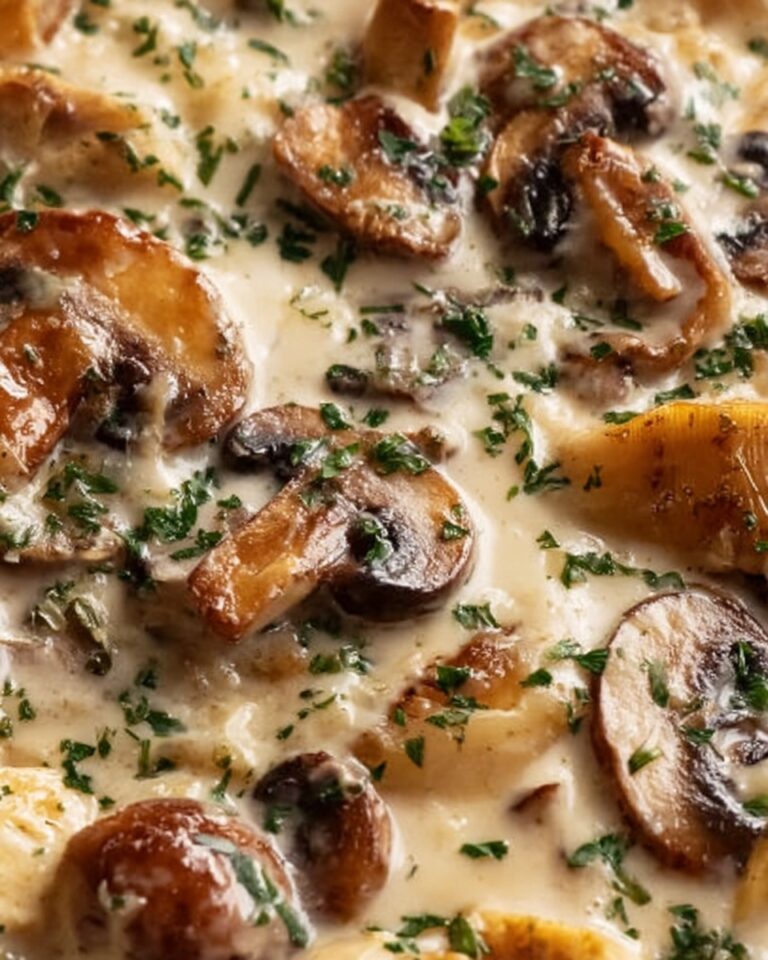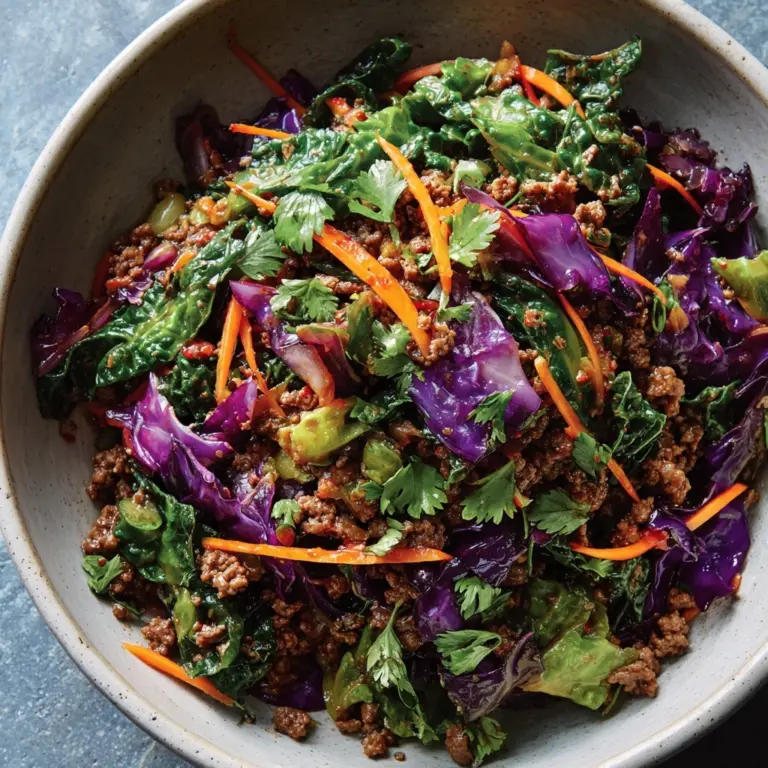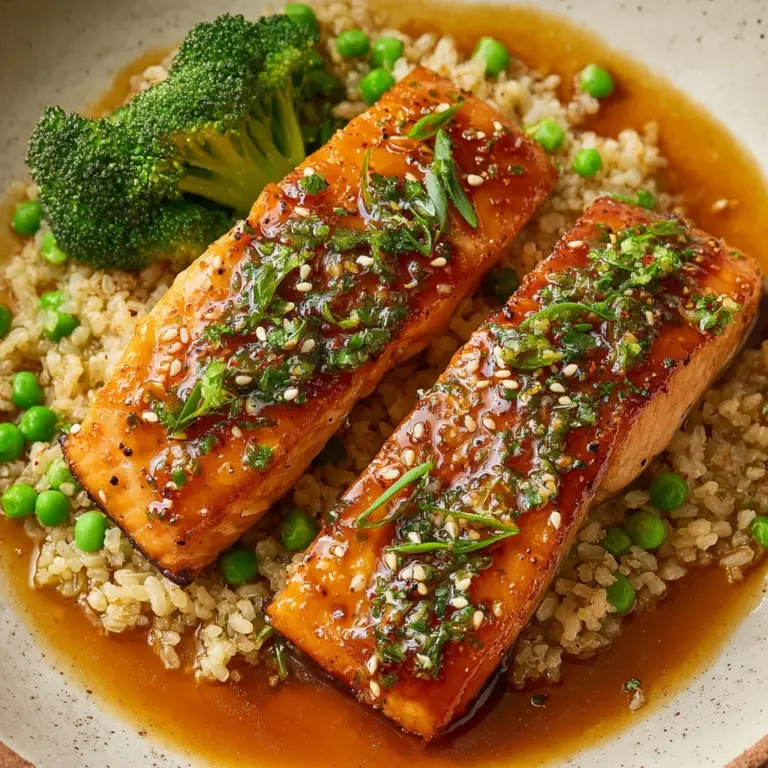If you crave a dish that bursts with bold flavors and comes together in a flash, this Sweet & Spicy Gochujang Shrimp Recipe is an absolute game-changer. The tender shrimp get coated in a vibrant sauce that perfectly balances the fiery kick of gochujang with a touch of honey’s sweetness, all enhanced by the savory depth of soy and the zing of fresh garlic and ginger. It’s a delightful dance of heat, sweet, and tang that’s not only packed with flavor but also quick enough for a busy weeknight dinner. Trust me, once you try this recipe, it’ll become your go-to for impressing guests or treating yourself to something sensational.

Ingredients You’ll Need
The beauty of this Sweet & Spicy Gochujang Shrimp Recipe lies in its simplicity. Each ingredient plays a crucial role in building layers of flavor and ensuring the shrimp stays tender and juicy. The balance between spicy, sweet, and tangy elements makes every bite exciting and satisfying.
- 1 lb large shrimp, peeled and deveined: The star ingredient, juicy and quick to cook.
- 1 tbsp olive oil or neutral oil: Perfect for searing shrimp to a golden finish without overpowering flavors.
- Salt and pepper, to taste: Simple seasoning that enhances the shrimp’s natural sweetness.
- 2 tbsp gochujang: This Korean chili paste provides the signature spicy depth.
- 1 tbsp honey (or maple syrup): Adds a natural sweetness that mellows the heat.
- 1 tbsp soy sauce: Brings umami richness and a little saltiness to the sauce.
- 1 tbsp rice vinegar: Introduces a pleasant tang that brightens the dish.
- 1 tsp sesame oil: A nutty aroma that finishes the sauce with finesse.
- 2 garlic cloves, minced: Fresh garlic infuses a bold, aromatic punch.
- 1 tsp grated fresh ginger (optional): Adds a subtle warmth and complexity.
- 1–2 tsp water (to thin sauce, if needed): Adjusts sauce consistency for perfect coating.
- Sesame seeds: A toasty garnish that also adds a delicate crunch.
- Sliced green onions: Bright, fresh, and slightly sharp for contrast.
- Lime wedges: A squeeze of citrus lifts flavors and adds freshness.
How to Make Sweet & Spicy Gochujang Shrimp Recipe
Step 1: Prep and Season the Shrimp
Start by patting your shrimp dry with paper towels. This step is key because it ensures a nice sear rather than steaming them in the pan. Once dry, season lightly with salt and pepper. This simple seasoning enhances the shrimp’s natural flavor and prepares it to soak up the delicious sauce later on.
Step 2: Whisk Together the Flavor-Packed Sauce
In a small bowl, combine the gochujang, honey, soy sauce, rice vinegar, sesame oil, minced garlic, and grated ginger if you’re using it. Whisk everything until smooth. The combination creates a sauce that’s simultaneously spicy, sweet, and tangy, promising a bold flavor explosion. If your sauce feels too thick, add a teaspoon or two of water until it’s pourable yet still coats the shrimp beautifully.
Step 3: Sear the Shrimp to Perfection
Heat your oil in a large skillet over medium-high heat. When the oil shimmers, lay the shrimp in a single layer, ensuring they aren’t crowded. Cook for 1–2 minutes on each side until the shrimp turn pink and develop a light sear. The quick cooking keeps them tender and juicy without becoming rubbery.
Step 4: Coat and Simmer in Sauce
Reduce the heat to medium and pour the prepared sauce over the shrimp. Toss everything gently to make sure each piece is thoroughly coated. Let it simmer for 1–2 minutes until the sauce thickens and becomes glossy, clinging perfectly to each shrimp. This step intensifies the flavors and creates that irresistible sticky finish.
Step 5: Garnish and Serve Immediately
Once your shrimp are beautifully glazed and aromatic, remove the skillet from heat. Sprinkle generously with toasted sesame seeds and vibrant sliced green onions. Don’t forget a generous squeeze of lime juice to add a fresh, citrusy brightness right before serving. The result is a dish that looks as delightful as it tastes.
How to Serve Sweet & Spicy Gochujang Shrimp Recipe
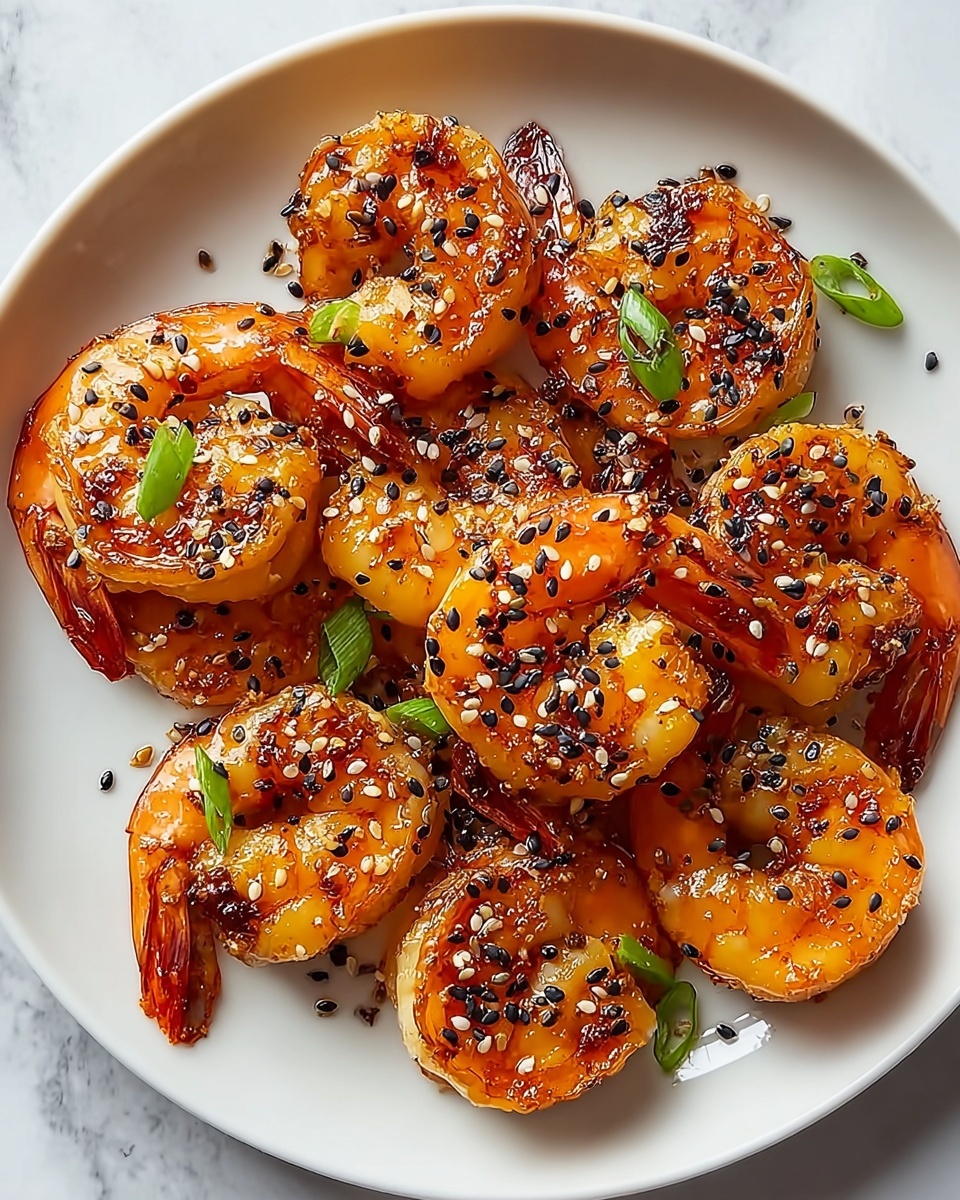
Garnishes
The final touches make all the difference here. Besides sesame seeds and sliced green onions, you can add thinly sliced red chili for extra heat or fresh cilantro for a herbaceous note. Lime wedges on the side invite everyone to personalize their zing factor.
Side Dishes
Because the shrimp is packed with flavor, simple sides work beautifully. Think fluffy jasmine rice or sticky rice to soak up every bit of sauce. Crisp cucumber salad or steamed broccoli add freshness and crunch, balancing the richness. For a heartier meal, garlic fried rice or soba noodles tossed in sesame oil make fantastic companions.
Creative Ways to Present
Want to turn heads? Serve this Sweet & Spicy Gochujang Shrimp Recipe over a bed of creamy coconut rice or inside crunchy lettuce cups for a light and fun bite. You can also offer it as a stunning appetizer on skewers or atop rice paper rolls with fresh herbs and shredded veggies for a hand-held feast. Presentation adds to the overall experience and makes it party-perfect too.
Make Ahead and Storage
Storing Leftovers
If you’re lucky enough to have leftovers, store the shrimp and sauce together in an airtight container in the refrigerator. They’ll stay fresh and flavorful for up to two days, making for a quick and delicious next-day meal.
Freezing
Freezing shrimp after cooking isn’t ideal as the texture can suffer, but you can freeze the sauce separately for up to a month. Thaw it in the fridge and quickly toss freshly cooked shrimp in the warmed sauce for an easy meal any time.
Reheating
To warm leftover shrimp, gently heat them in a skillet over medium-low heat just until warmed through. Avoid overcooking to keep the shrimp tender. Add a splash of water or a bit of extra sauce if needed to keep them moist and flavorful.
FAQs
Can I use frozen shrimp for this recipe?
Yes, you can! Just be sure to thaw them completely and pat dry before cooking to ensure a good sear and avoid excess moisture that can dilute the sauce.
What if I don’t have gochujang? Any substitutes?
While gochujang is unique in flavor, you could mix a bit of chili paste or Sriracha with miso paste or even a touch of soy sauce and honey to approximate the sweet, smoky, spicy profile, but the original is best.
Is this recipe very spicy?
The heat level is moderate—balanced by the honey’s sweetness—so it’s approachable for most palates. To make it milder, just reduce the gochujang slightly or add extra honey.
Can I use this sauce for other proteins?
Absolutely! This Sweet & Spicy Gochujang Shrimp Recipe sauce works beautifully on chicken, tofu, or even vegetables like roasted cauliflower for a tasty twist.
How long can I store leftovers in the fridge?
Leftover shrimp with sauce should be consumed within 2 days for the best taste and safety. Always keep them in an airtight container.
Final Thoughts
Once you try this Sweet & Spicy Gochujang Shrimp Recipe, you’ll wonder why you haven’t been making it all along. It’s quick, packed with exciting flavors, and incredibly satisfying, perfect for any night when you want something delicious without fuss. Give it a whirl and watch it become a favorite in your kitchen rotation—you’ll thank me later!
Print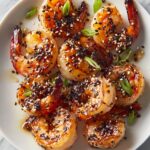
Sweet & Spicy Gochujang Shrimp Recipe
- Prep Time: 10 minutes
- Cook Time: 10 minutes
- Total Time: 20 minutes
- Yield: 4 servings
- Category: Main Dish
- Method: Stovetop
- Cuisine: Korean-American Fusion
Description
This Sweet & Spicy Gochujang Shrimp recipe features tender shrimp cooked to perfection and coated in a vibrant sauce made with Korean gochujang, honey, soy sauce, and a touch of sesame oil. Quick to prepare and packed with bold flavors, this dish is perfect for a weeknight dinner or a flavorful appetizer, garnished with sesame seeds, green onions, and fresh lime wedges for a refreshing finish.
Ingredients
Shrimp
- 1 lb large shrimp, peeled and deveined
- 1 tbsp olive oil or neutral oil
- Salt and pepper, to taste
Sauce
- 2 tbsp gochujang
- 1 tbsp honey (or maple syrup)
- 1 tbsp soy sauce
- 1 tbsp rice vinegar
- 1 tsp sesame oil
- 2 garlic cloves, minced
- 1 tsp grated fresh ginger (optional)
- 1–2 tsp water (to thin sauce, if needed)
Garnish
- Sesame seeds
- Sliced green onions
- Lime wedges
Instructions
- Prepare the shrimp: Pat the shrimp dry using paper towels to remove excess moisture, then season lightly with salt and pepper to enhance the natural flavors.
- Make the sauce: In a small bowl, whisk together gochujang, honey, soy sauce, rice vinegar, sesame oil, minced garlic, and grated ginger until combined. Add 1 to 2 teaspoons of water if the sauce is too thick to achieve a smooth consistency.
- Cook the shrimp: Heat the olive or neutral oil in a large skillet over medium-high heat. Arrange the shrimp in a single layer and cook each side for 1 to 2 minutes until shrimp turn pink and develop a light sear.
- Combine shrimp with sauce: Reduce the heat to medium. Pour the prepared sauce over the shrimp and toss to coat evenly. Let it simmer for 1 to 2 minutes until the sauce thickens and becomes glossy, ensuring the shrimp are fully coated with flavor.
- Garnish and serve: Remove the skillet from heat. Garnish the shrimp with sesame seeds, sliced green onions, and a squeeze of fresh lime juice. Serve immediately while warm for the best taste and texture.
Notes
- To make this dish vegan or vegetarian, substitute shrimp with tofu or vegetables and use a plant-based soy sauce.
- If you prefer less heat, reduce the amount of gochujang or omit the ginger.
- Serve with steamed rice or noodles to make a complete meal.
- Gochujang can be found in most Asian grocery stores or online.
- Adjust the sweetness by substituting honey with maple syrup to suit dietary preferences.



